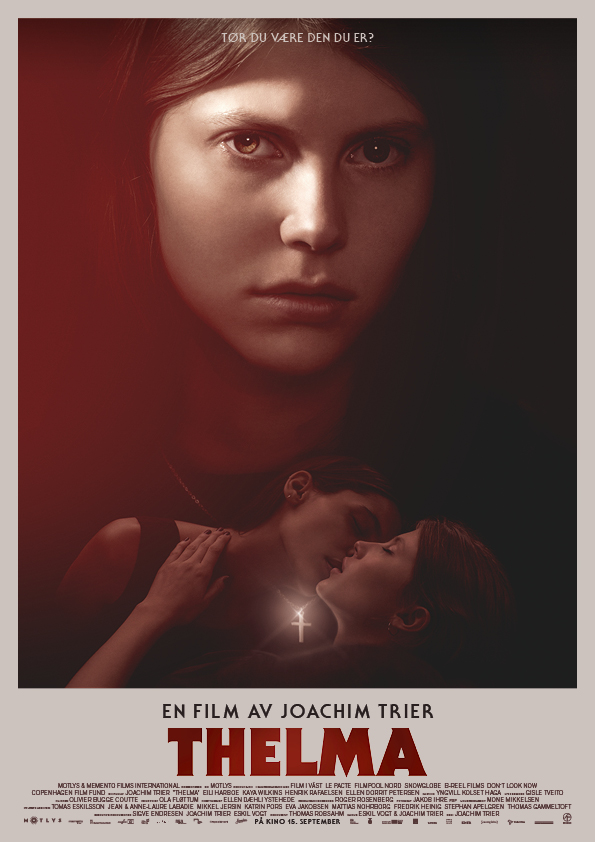A Woman in Love can Burn Down the World: A Movie Review
Sometimes the most terrifying discovery is who you are.
May 29, 2018
“There’something in you. If you want something, if you really want something, – – what you’re thinking, feeling, something in you makes it happen.” — Henrik Rafaelsen (Trond), Thelma
The fun part of watching Joachim Trier’s Thelma is trying to reconcile the film’s gorgeous, Nordic-art-house film-style with its exploratory psychological-horror-movie plotting, which makes the whole thing feel like a tasteful Norwegian remake of Carrie, which it very well might be. The movie begins twice, once in a disturbing scene where a man aims his rifle at a little girl in a desolate winter tableau. Whether this girl is our girl, the movie refuses to say. In stead, the story shifts to Oslo, where it remains with the title character for a while. She lives alone, out of her suitcase, in one of those eerily ambiguous apartment buildings where no one knows your name or cares.
Thelma is a female coming-of-age story back-lit by the manifestation of a college student’s latent psychic powers. The obscurity and precarious nature of this power adds an eerie dimensional layer to the cinematography, as does the buttoned-up Scandinavian mood. The movie is incredibly formal, meticulously Hitchcockian, but with even more longueurs. Lengthy over-head shots of clean, impersonal settings and ominous, lingering pans instill in the audience a fear of some unknown predator. Even the young-adult title character, played by Eili Harboe, seems to be constantly anxious, but this can be attributed to her isolation; she knows no one, she’s afraid to interact.
As it turns out, she has good reason. Her apprehensive father, Trond (Henrik Rafaelson), and emotionally desolate mother, Unni (Ellen Dorrit Peterson), are ultraconservative-religious praetorians, who have (being just shy of cliche) desperately embraced the rapacious will of the Creator, as if fleeing the fires below. They sheltered Thelma, leaving her in a child-like state of dependence, removed from the state of nature. But nature, as it does, creeps back into her life. In the traditional Hitchcockian sense, black birds gather. A snake slithers into a building on campus. More birds. More portent. While studying in the library, Thelma exchanges glances with another female student and something within her is stirred, literally and figuratively: she collapses, seizing. It is now that the tone of the film shifts dramatically. A murder of crows gathers in the clouded sky. Birds across campus fly headlong into windows. After a few more such incidents, there’s one of those brain scan scenes in which the apparatus attached to Thelma’s head seems analogous to a heart, the wires pumping electricity like blood through veins and the doctors stare at the readout with widening eyes.
Thelma’s friendship with a young woman, Anja (Kaya Wilkins), grounds the latter half of the film in the realm of the “love that dare not speak its name”—especially if your parents are fundamentalist Christians terrified of unleashing the primal forces within. Thelma and Anja grow closer, sharing intimacies, Thelma’s first beer, and eventually, a kiss. This erotic shock upends their world and shifts the movie into a leisurely horror-film meltdown. Those aforementioned primeval forces extend to the audience. Thelma opens, quite aptly, with a warning to epileptics and anyone else averse to strobe lighting, and I heartily agree. The flashy dance scenes are intense. I thought that I might have had a seizure at one point.
The concept of Thelma seems a little predictable on paper. Revenge of the repressed… liberation of the feminine… delayed expression of the nascent “chthonian nature” of women. And, alas, the final scene reduces all of the preceding excellence to a flat-out-insulting point. But the rest of the film is the entrancingly beautiful art-horror promised to the audience by Trier in his cool, Scandinavian affection. A rather late flashback is filled with poetically terrifying imagery—Imagery you may wish to retrospectively unsee. A final scene between Trond and Thelma is an artful mixture of lyricism and ruthlessness. (It’s too bad the film didn’t end there.)
Harboe has a cherubic, expressively feminine face that, throughout the film, you can’t peel your eyes from. It suggests that she is always one step behind her emotions, but where are they leading her?
Thelma takes the concept of the female naif and some easily recognizable narrative ideas and arranges them in a way that is too unruly to fit in a box. It is a traditional European art-film (a personal favorite of mine) that flirts heavily with the horror genre. But it’s also as romance, a psychological thriller, a bildungsroman, a liberation story and a mystery. Mostly, and most satisfyingly, it teases the female Gothic, those unnerving tales—churning with dread and desire, quivering with anticipation and suspicion—wherein women are simultaneously the victims and agents of change.
The Norwegian Trier, has now penned and directed four decent films, none of which follow a similar key. His first, Reprise, is a tricky psycho-dramatic buddy movie. Oslo, August 31st is a switchback ride to suicide—the second attempt (after Louis Malle) at the novel The Fire Within. Louder Than Bombs is a moving American family drama that unfortunately bombed. Thelma is both more mysterious and more accessible than his other films. The inauspicious spell it casts transcends the silly plotting. Thelma’s anguish can shatter a wall of glass, but her story is never more frighteningly poignant than when she is just another lonely girl in the frame.
